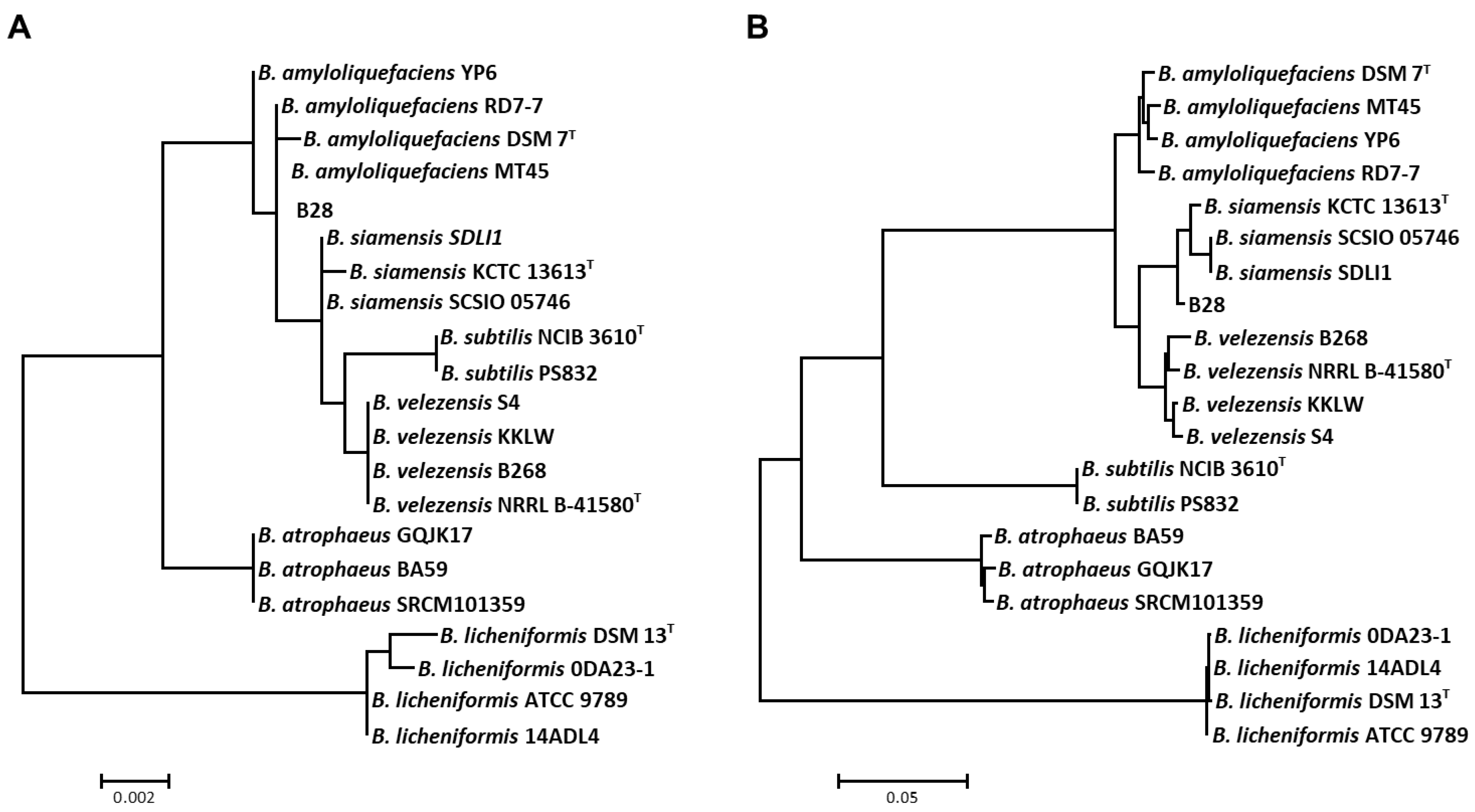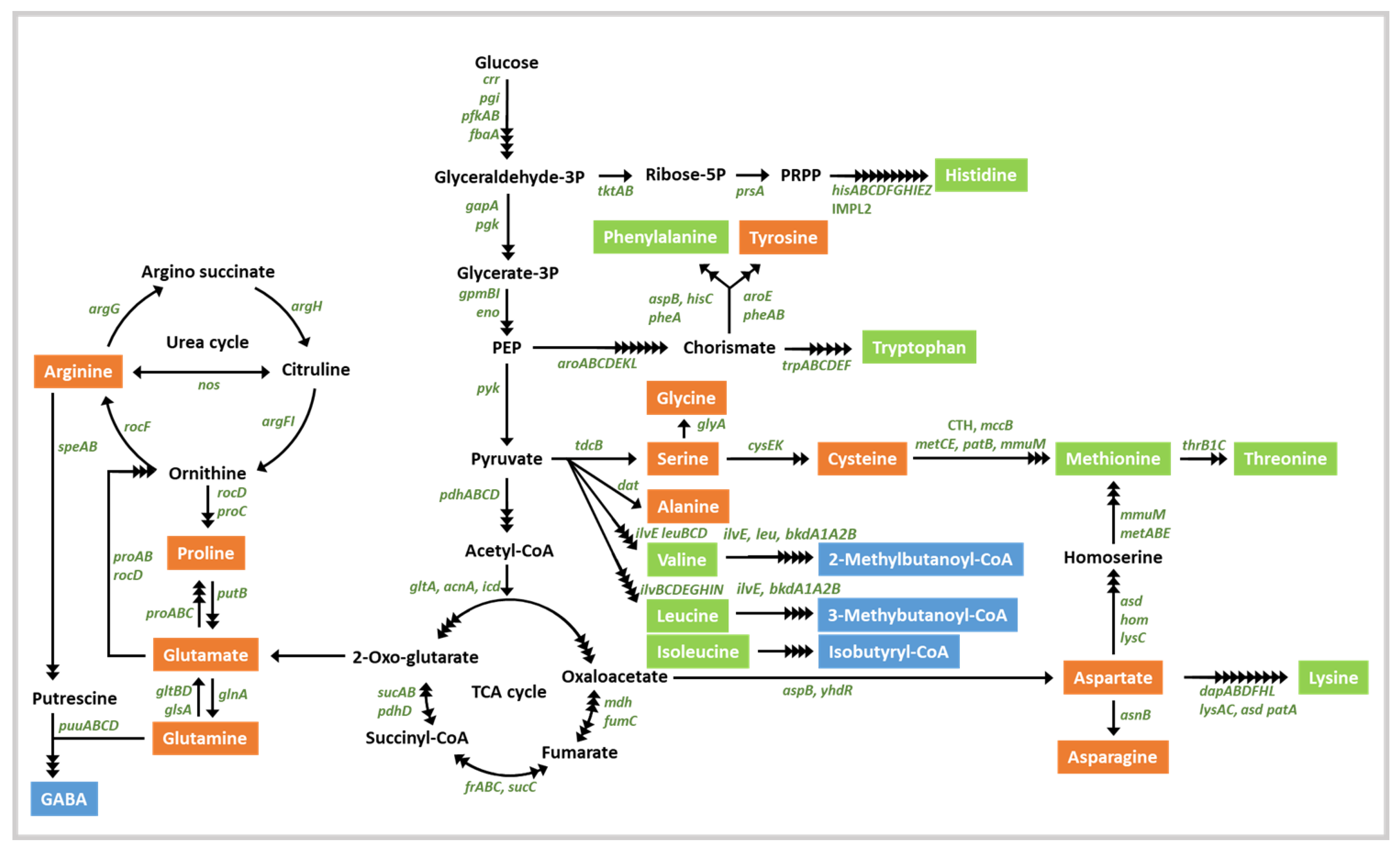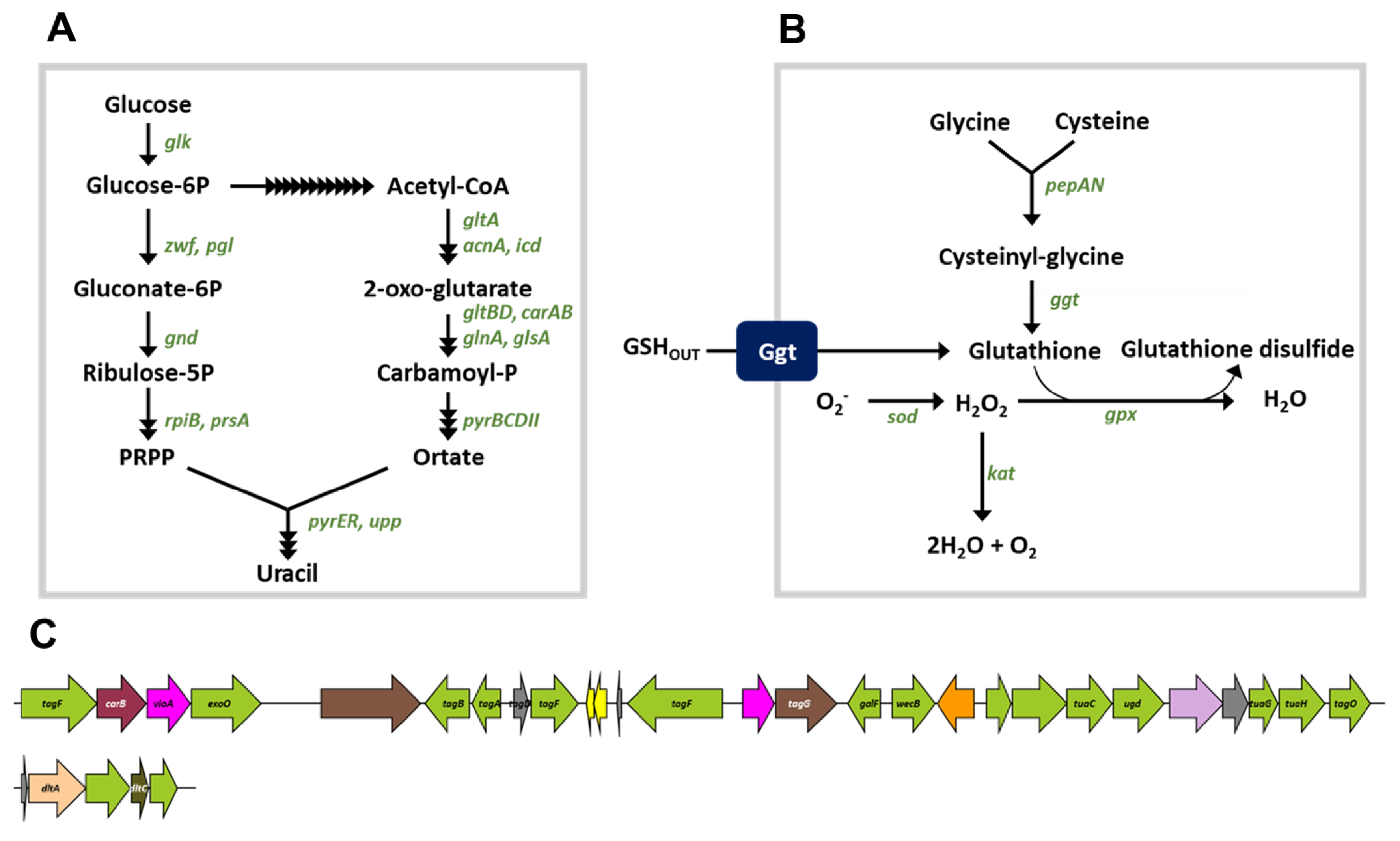Functional Genomic Insights into Probiotic Bacillus siamensis Strain B28 from Traditional Korean Fermented Kimchi
Abstract
1. Introduction
2. Materials and Methods
2.1. Bacterial Strains and Culture Conditions
2.2. Genomic DNA Preparation and Genome Sequencing
2.3. Comparative Genomics
2.4. Multilocus Sequence Typing
2.5. Disc Diffusion Analysis
2.6. Hemolytic Activity Tests
2.7. Enterotoxin Gene Amplification
2.8. Determination of Antibacterial Activity
2.9. Database Accession Numbers
3. Results and Discussion
3.1. Species Classification of Strain B28
3.2. General Genome Characteristics of Strain B28
3.3. Insights into Virulence of B. siamensis Strain B28
3.4. Probiotic Properties of B. siamensis Strain B28
3.4.1. Survivability of Strain B28
3.4.2. Adhesive Ability of Strain B28
3.4.3. Antibacterial Activity
3.4.4. Potential for Health Enhancement by Strain B28
Supplementary Materials
Author Contributions
Funding
Institutional Review Board Statement
Informed Consent Statement
Data Availability Statement
Acknowledgments
Conflicts of Interest
References
- Adimpong, D.B.; Sorensen, K.I.; Thorsen, L.; Stuer-Lauridsen, B.; Abdelgadir, W.S.; Nielsen, D.S.; Derkx, P.M.; Jespersen, L. Antimicrobial susceptibility of Bacillus strains isolated from primary starters for African traditional bread production and characterization of the bacitracin operon and bacitracin biosynthesis. Appl. Environ. Microbiol. 2012, 78, 7903–7914. [Google Scholar] [CrossRef] [PubMed]
- Ahaotu, I.; Anyogu, A.; Njoku, O.H.; Odu, N.N.; Sutherland, J.P.; Ouoba, L.I. Molecular identification and safety of Bacillus species involved in the fermentation of African oil beans (Pentaclethra macrophylla Benth) for production of Ugba. Int. J. Food Microbiol. 2013, 162, 95–104. [Google Scholar] [CrossRef] [PubMed]
- Eom, J.S.; Seo, B.Y.; Choi, H.S. Biogenic mine degradation by Bacillus species isolated from traditional fermented soybean food and detection of decarboxylase-related genes. J. Microbiol. Biotechnol. 2015, 25, 1519–1527. [Google Scholar] [CrossRef] [PubMed]
- Jeong, D.W.; Jeong, M.; Lee, J.H. Antibiotic susceptibilities and characteristics of Bacillus licheniformis isolates from traditional Korean fermented soybean foods. LWT Food Sci. Technol. 2017, 75, 565–568. [Google Scholar] [CrossRef]
- Lee, B.; Lee, H.; Jeong, D.W.; Lee, J.H. A rapid isolation method for Bacillus coagulans from Rice Straw. Microbiol. Biotechnol. Lett. 2015, 43, 401–404. [Google Scholar] [CrossRef]
- Hong, H.A.; Khaneja, R.; Tam, N.M.K.; Cazzato, A. Bacillus subtilis isolated from the human gastrointestinal tract. Res. Microbiol. 2008, 160, 134–143. [Google Scholar] [CrossRef]
- An, D.; Kim, H.R.; Jeong, D.W.; Caldwell, J.M.; Lee, J.H. Bacterial community monitoring of commercial kimchi produced in Korea and China with evidence of bacilli spore formation during fermentation. Microbiol. Biotechnol. Lett. 2014, 42, 121–130. [Google Scholar] [CrossRef]
- Cho, M.S.; Jin, Y.J.; Kang, B.K.; Park, Y.K.; Kim, C.; Park, D.S. Understanding the ontogeny and succession of Bacillus velezensis and B. subtilis subsp. subtilis by focusing on kimchi fermentation. Sci. Rep. 2018, 8, 7045. [Google Scholar]
- Jeong, D.W.; Lee, H.; Jeong, K.; Kim, C.T.; Shim, S.T.; Lee, J.H. Effects of starter candidates and NaCl on the production of volatile compounds during soybean fermentation. J. Microbiol. Biotechnol. 2019, 29, 191–199. [Google Scholar] [CrossRef] [PubMed]
- Lee, J.H.; Jeong, D.W.; Kim, M.K. Influence of bacterial starter cultures on the sensory characteristics of doenjang, a fermented soybean paste, and their impact on consumer hedonic perception. J. Sens. Stud. 2019, 34, e12508. [Google Scholar] [CrossRef]
- Sharma, R.; Garg, P.; Kumar, P.; Bhatia, S.K.; Kulshrestha, S. Microbial fermentation and its role in quality improvement of fermented foods. Fermentation 2020, 6, 106. [Google Scholar] [CrossRef]
- Anisha, A.H.; Anandham, R.; Kwon, S.W.; Gandhi, P.I.; Gopal, N.O. Evaluation of Bacillus spp. as dough starters for Adhirasam—A traditional rice based fermented food of Southern India. Braz. J. Microbiol. 2015, 46, 1183–1191. [Google Scholar] [CrossRef] [PubMed]
- Jeong, D.W.; Heo, S.; Lee, B.; Lee, H.; Jeong, K.; Her, J.Y.; Lee, K.G.; Lee, J.H. Effects of the predominant bacteria from meju and doenjang on the production of volatile compounds during soybean fermentation. Int. J. Food Microbiol. 2017, 262, 8–13. [Google Scholar] [CrossRef] [PubMed]
- Shin, D.; Jeong, D. Korean traditional fermented soybean products: Jang. J. Ethn. Foods 2015, 2, 2–7. [Google Scholar] [CrossRef]
- Heo, S.; Kim, J.H.; Kwak, M.S.; Sung, M.H.; Jeong, D.W. Functional annotation genome unravels potential probiotic Bacillus velezensis strain KMU01 from traditional Korean fermented Kimchi. Foods 2021, 10, 563. [Google Scholar] [CrossRef] [PubMed]
- Kim, Y.S.; Lee, J.; Heo, S.; Lee, J.H.; Jeong, D.W. Technology and safety evaluation of Bacillus coagulans exhibiting antimicrobial activity for starter development. LWT Food Sci. Technol. 2021, 137, 110464. [Google Scholar] [CrossRef]
- Ma, E.L.; Choi, Y.J.; Choi, J.; Pothoulakis, C.; Rhee, S.-J.H.; Im, E. The anticancer effect of probiotic Bacillus polyfermenticus on human colon cancer cells is mediated through ErbB2 and ErbB3 inhibition. Int. J. Cancer 2010, 127, 780–790. [Google Scholar] [CrossRef] [PubMed]
- Hong, H.A.; Duc, L.H.; Cutting, S.M. The use of bacterial spore formers as probiotics. FEMS Microbiol. Rev. 2005, 29, 813–835. [Google Scholar] [CrossRef]
- Oh, S.; Sung, M.H. A Cosmetic Composition Comprising Bacillus polyfermenticus Extract. Korean Patent 10-1843926, 26 March 2018. [Google Scholar]
- Parte, A.C.; Sarda Carbasse, J.; Meier-Kolthoff, J.P.; Reimer, L.C.; Goker, M. List of Prokaryotic names with Standing in Nomenclature (LPSN) moves to the DSMZ. Int. J. Syst. Evol. Microbiol. 2020, 70, 5607–5612. [Google Scholar] [CrossRef]
- Jeong, H.; Kim, J.; Choi, S.K.; Pan, J.G. Genome sequence of the probiotic strain Bacillus velezensis variant polyfermenticus GF423. Microbiol. Res. Announc. 2018, 7, e01000-18. [Google Scholar] [CrossRef]
- Zimin, A.V.; Marcais, G.; Puiu, D.; Roberts, M.; Salzberg, S.L.; Yorke, J.A. The MaSuRCA genome assembler. Bioinformatics 2013, 29, 2669–2677. [Google Scholar] [CrossRef]
- Antipov, D.; Hartwick, N.; Shen, M.; Raiko, M.; Lapidus, A.; Pevzner, P.A. plasmidSPAdes: Assembling plasmids from whole genome sequencing data. Bioinformatics 2016, 32, 3380–3387. [Google Scholar] [CrossRef]
- Kelley, D.R.; Liu, B.; Delcher, A.L.; Pop, M.; Salzberg, S.L. Gene prediction with Glimmer for metagenomic sequences augmented by classification and clustering. Nucleic. Acids Res. 2012, 40, e9. [Google Scholar] [CrossRef] [PubMed]
- Tatusova, T.; DiCuccio, M.; Badretdin, A.; Chetvernin, V.; Nawrocki, E.P.; Zaslavsky, L.; Lomsadze, A.; Pruitt, K.D.; Borodovsky, M.; Ostell, J. NCBI prokaryotic genome annotation pipeline. Nucleic. Acids Res. 2016, 44, 6614–6624. [Google Scholar] [CrossRef] [PubMed]
- Tatusov, R.L.; Koonin, E.V.; Lipman, D.J. A genomic perspective on protein families. Science 1997, 278, 631–637. [Google Scholar] [CrossRef]
- Goris, J.; Konstantinidis, K.T.; Klappenbach, J.A.; Coenye, T.; Vandamme, P.; Tiedje, J.M. DNA-DNA hybridization values and their relationship to whole-genome sequence similarities. Int. J. Syst. Evol. Microbiol. 2007, 57, 81–91. [Google Scholar] [CrossRef]
- Blom, J.; Kreis, J.; Spanig, S.; Juhre, T.; Bertelli, C.; Ernst, C.; Goesmann, A. EDGAR 2.0: An enhanced software platform for comparative gene content analyses. Nucleic. Acids Res. 2016, 44, W22–W28. [Google Scholar] [CrossRef] [PubMed]
- Aziz, R.K.; Bartels, D.; Best, A.A.; DeJongh, M.; Disz, T.; Edwards, R.A.; Formsma, K.; Gerdes, S.; Glass, E.M.; Kubal, M.; et al. The RAST Server: Rapid annotations using subsystems technology. BMC Genom. 2008, 9, 75. [Google Scholar] [CrossRef] [PubMed]
- Darzi, Y.; Letunic, I.; Bork, P.; Yamada, T. iPath3.0: Interactive pathways explorer v3. Nucleic Acids Res. 2018, 46, W510–W513. [Google Scholar] [CrossRef]
- Jeong, D.W.; Lee, B.; Lee, H.; Jeong, K.; Jang, M.; Lee, J.H. Urease characteristics and phylogenetic status of Bacillus paralicheniformis. J. Microbiol. Biotechnol. 2018, 28, 1992–1998. [Google Scholar] [CrossRef]
- Kumar, S.; Stecher, G.; Tamura, K. MEGA7: Molecular evolutionary genetics analysis version 7.0 for bigger datasets. Mol. Biol. Evol. 2016, 33, 1870–1874. [Google Scholar] [CrossRef]
- Clinical and Laboratory Standards Institute. Performance Standards for Antimicrobial Susceptibility Testing; Seventeenth Informational Supplement; CLSI: Wayne, PA, USA, 2007. [Google Scholar]
- Jeong, D.W.; Cho, H.; Lee, H.; Li, C.; Garza, J.; Fried, M.; Bae, T. Identification of the P3 promoter and distinct roles of the two promoters of the SaeRS two-component system in Staphylococcus aureus. J. Bacteriol. 2011, 193, 4672–4684. [Google Scholar] [CrossRef]
- Abbas, B.A.; Khudor, M.H.; Saeed, B.M.S. Detection of hbl, nhe and bceT toxin genes in Bacillus cereus isolates by multiplex PCR. Int. J. Curr. Microbiol. App. Sci. 2014, 3, 1009–1016. [Google Scholar]
- Liu, X.; Champagne, C.P.; Lee, B.H.; Boye, J.I.; Casgrain, M. Thermostability of probiotics and their alpha-galactosidases and the potential for bean products. Biotechnol. Res. Int. 2014, 2014, 472723. [Google Scholar] [CrossRef]
- Di Stefano, M.; Miceli, E.; Gotti, S.; Missanelli, A.; Mazzocchi, S.; Corazza, G.R. The effect of oral alpha-galactosidase on intestinal gas production and gas-related symptoms. Dig. Dis. Sci. 2007, 52, 78–83. [Google Scholar] [CrossRef] [PubMed]
- Seitz, E.W. Microbial and enzyme-induced flavors in dairy foods. J. Dairy Sci. 1990, 73, 3664–3691. [Google Scholar] [CrossRef]
- Senesi, S.; Ghelardi, E. Production, secretion and biological activity of Bacillus cereus enterotoxins. Toxins 2010, 2, 1690–1703. [Google Scholar] [CrossRef] [PubMed]
- Chen, Y.C.; Chang, M.C.; Chuang, Y.C.; Jeang, C.L. Characterization and virulence of hemolysin III from Vibrio vulnificus. Curr. Microbiol. 2004, 49, 175–179. [Google Scholar] [CrossRef] [PubMed]
- Robertson, K.P.; Smith, C.J.; Gough, A.M.; Rocha, E.R. Characterization of Bacteroides fragilis hemolysins and regulation and synergistic interactions of HlyA and HlyB. Infect. Immun. 2006, 74, 2304–2316. [Google Scholar] [CrossRef]
- Jeong, D.W.; Heo, S.; Ryu, S.; Blom, J.; Lee, J.H. Genomic insights into the virulence and salt tolerance of Staphylococcus equorum. Sci. Rep. 2017, 7, 5383. [Google Scholar] [CrossRef]
- Heo, S.; Lee, J.H.; Jeong, D.W. Complete genome sequence of Staphylococcus xylosus strain DMSX03 from fermented soybean, meju. Korean J. Microbiol. 2021, 57, 52–54. [Google Scholar]
- Jeong, D.W.; Lee, B.; Heo, S.; Jang, M.; Lee, J.H. Complete genome sequence of Bacillus licheniformis strain 0DA23-1, a potential starter culture candidate for soybean fermentation. Korean J. Microbiol. 2018, 54, 453–455. [Google Scholar]
- Lee, J.; Heo, S.; Kim, Y.-S.; Lee, J.H.; Jeong, D.W. Complete genome sequence of Bacillus coagulans strain ASRS217, a potential food fermentation starter culture. Korean J. Microbiol. 2020, 56, 321–323. [Google Scholar]
- Binda, S.; Hill, C.; Johansen, E.; Obis, D.; Pot, B.; Sanders, M.E.; Tremblay, A.; Ouwehand, A.C. Criteria to qualify microorganisms as “Probiotic” in foods and dietary supplements. Front. Microbiol. 2020, 11, 1662. [Google Scholar] [CrossRef]
- Granato, D.; Bergonzelli, G.E.; Pridmore, R.D.; Marvin, L.; Rouvet, M.; Corthesy-Theulaz, I.E. Cell surface-associated elongation factor Tu mediates the attachment of Lactobacillus johnsonii NCC533 (La1) to human intestinal cells and mucins. Infect. Immun. 2004, 72, 2160–2169. [Google Scholar] [CrossRef] [PubMed]
- Henderson, B.; Nair, S.; Pallas, J.; Williams, M.A. Fibronectin: A multidomain host adhesin targeted by bacterial fibronectin-binding proteins. FEMS Microbiol. Rev. 2011, 35, 147–200. [Google Scholar] [CrossRef] [PubMed]
- Salas-Jara, M.J.; Ilabaca, A.; Vega, M.; Garcia, A. Biofilm Forming Lactobacillus: New challenges for the development of probiotics. Microorganisms 2016, 4, 35. [Google Scholar] [CrossRef] [PubMed]
- Haiko, J.; Westerlund-Wikstrom, B. The role of the bacterial flagellum in adhesion and virulence. Biology 2013, 2, 1242–1267. [Google Scholar] [CrossRef]
- Dons, L.; Eriksson, E.; Jin, Y.; Rottenberg, M.E.; Kristensson, K.; Larsen, C.N.; Bresciani, J.; Olsen, J.E. Role of flagellin and the two-component CheA/CheY system of Listeria monocytogenes in host cell invasion and virulence. Infect. Immun. 2004, 72, 3237–3244. [Google Scholar] [CrossRef] [PubMed]
- Neumuller, A.M.; Konz, D.; Marahiel, M.A. The two-component regulatory system BacRS is associated with bacitracin “self-resistance” of Bacillus licheniformis ATCC 10716. Eur. J. Biochem. 2001, 268, 3180–3189. [Google Scholar] [CrossRef]
- Ward, J.B. The synthesis of peptidoglycan in an autolysin-deficient mutant of Bacillus licheniformis N.C.T.C. 6346 and the effect of beta-lactam antibiotics, bacitracin and vancomycin. Biochem. J. 1974, 141, 227–241. [Google Scholar] [CrossRef] [PubMed]
- Fremaux, C.; Hechard, Y.; Cenatiempo, Y. Mesentericin Y105 gene clusters in Leuconostoc mesenteroides Y105. Microbiology 1995, 141, 1637–1645. [Google Scholar] [CrossRef]
- Nikmaram, N.; Dar, B.N.; Roohinejad, S.; Koubaa, M.; Barba, F.J.; Greiner, R.; Johnson, S.K. Recent advances in gamma-aminobutyric acid (GABA) properties in pulses: An overview. J. Sci. Food Agric. 2017, 97, 2681–2689. [Google Scholar] [CrossRef]
- Taormina, V.M.; Unger, A.L.; Schiksnis, M.R.; Torres-Gonzalez, M.; Kraft, J. Branched-chain fatty acids—An underexplored class of dairy-derived fatty acids. Nutrients 2020, 12, 2875. [Google Scholar] [CrossRef]
- Lee, N.R.; Go, T.H.; Lee, S.M.; Jeong, S.Y.; Park, G.T.; Hong, C.O.; Son, H.J. In vitro evaluation of new functional properties of poly-gamma-glutamic acid produced by Bacillus subtilis D7. Saudi. J. Biol. Sci. 2014, 21, 153–158. [Google Scholar] [CrossRef]
- Fujita, M.; Ohnishi, K.; Takaoka, S.; Ogasawara, K.; Fukuyama, R.; Nakamuta, H. Antihypertensive effects of continuous oral administration of nattokinase and its fragments in spontaneously hypertensive rats. Biol. Pharm. Bull. 2011, 34, 1696–1701. [Google Scholar] [CrossRef]
- Fernandes, M.S.; Kerkar, S. Microorganisms as a source of tyrosinase inhibitors: A review. Ann. Microbiol. 2017, 67, 343–358. [Google Scholar] [CrossRef]
- Sonthalia, S.; Daulatabad, D.; Sarkar, R. Glutathione as a skin whitening agent: Facts, myths, evidence and controversies. Indian J. Dermatol. Venereol. Leprol. 2016, 82, 262–272. [Google Scholar] [CrossRef] [PubMed]
- Liao, J.; Liu, P.P.; Hou, G.; Shao, J.; Yang, J.; Liu, K.; Lu, W.; Wen, S.; Hu, Y.; Huang, P. Regulation of stem-like cancer cells by glutamine through beta-catenin pathway mediated by redox signaling. Mol. Cancer 2017, 16, 51. [Google Scholar] [CrossRef] [PubMed]
- Hongisto, V.; Vainio, J.C.; Thompson, R.; Courtney, M.J.; Coffey, E.T. The Wnt pool of glycogen synthase kinase 3β is critical for trophic-deprivation-induced neuronal death. Mol. Cell Biol. 2008, 28, 1515–1527. [Google Scholar] [CrossRef][Green Version]
- Sumpavapol, P.; Tongyonk, L.; Tanasupawat, S.; Chokesajjawatee, N.; Luxananil, P.; Visessanguan, W. Bacillus siamensis sp. nov., isolated from salted crab (poo-khem) in Thailand. Int. J. Syst. Evol. Microbiol. 2010, 60, 2364–2370. [Google Scholar] [CrossRef] [PubMed]
- Jeong, D.W.; Kim, H.R.; Jung, G.; Han, S.; Kim, C.T.; Lee, J.H. Bacterial community migration in the ripening of doenjang, a traditional Korean fermented soybean food. J. Microbiol. Biotechnol. 2014, 24, 648–660. [Google Scholar] [CrossRef] [PubMed]
- Zheng, L.; Li, D.; Li, Z.L.; Kang, L.N.; Jiang, Y.Y.; Liu, X.Y.; Chi, Y.P.; Li, Y.Q.; Wang, J.H. Effects of Bacillus fermentation on the protein microstructure and anti-nutritional factors of soybean meal. Lett. Appl. Microbiol. 2017, 65, 520–526. [Google Scholar] [CrossRef] [PubMed]




| Feature | B28 | SCSIO 05746 | KCTC 13613T |
|---|---|---|---|
| Size (bp) | 3,957,728 | 4,280,711 | 3,779,696 |
| Chromosome size (bp) | 3,946,178 | 4,268,316 | - |
| G+C content (mol%) | 45.85 | 45.99 | 46.30 |
| No. of plasmids | 2 a | 1 b | - |
| Open reading frames | 4034 | 4375 | 3839 |
| CDSs assigned by COG c | 3573 | 3706 | 3451 |
| CDSs assigned by SEED d | 1663 | 1724 | 1617 |
| No. of rRNAs | 27 | 27 | 3 |
| No. of tRNAs | 86 | 86 | 78 |
| Contigs | 3 | 2 | 51 |
| Scaffolds | 0 | 0 | 51 |
| Origin | Kimchi | Sea mud | Salted crab |
| References | Complete | Complete | Draft |
| Gene Locus | Product | Gene a | KEEG b | COG | Presence of Gene in Bacillus Genomes | ||||
|---|---|---|---|---|---|---|---|---|---|
| B. siamensis | B. amyloliquefaciens | B. velezensis | |||||||
| SCSIO 05746 | FS1092 | RD7-7 | JJ-D34 | KMU01 | |||||
| Hemolysis-related | |||||||||
| JD965_RS10690 | Hemolysin-3 like protein | hlyIII | K11068 | S | ● | ● | ● | ● | ● |
| Antibiotic resistance | |||||||||
| JD965_RS01450 | Lincomycin resistance protein | lmrB | K18926 | P | ● | ● | ● | ● | ● |
| JD965_RS01610 | Multidrug resistance protein | K18935 | P | ● | ● | ● | ● | ● | |
| JD965_RS02265 | Small multidrug resistance pump | smr | K03297 | P | ● | ● | - | ● | ● |
| JD965_RS05435 | ATP-binding cassette, subfamily B, multidrug efflux pump | mdlA, smdA | K18889 | V | ● | ● | ● | ● | ● |
| JD965_RS05440 | ATP-binding cassette, subfamily B, multidrug efflux pump | mdlB, smdA | K18890 | V | ● | ● | ● | ● | ● |
| JD965_RS05865 | MFS transporter | blt | K08153 | G | ● | ● | ● | ● | ● |
| JD965_RS07140 | Paired small multidrug resistance pump | ykkC | K18924 | P | ● | ● | ● | ● | ● |
| JD965_RS07145 | Paired small multidrug resistance pump | ykkD | K18925 | P | ● | ● | ● | ● | ● |
| JD965_RS09245 | Small multidrug resistance pump | smr | K03297 | P | ● | ● | ● | ● | ● |
| JD965_RS09240 | Multidrug resistance protein | K11815 | P | ● | ● | ● | ● | ● | |
| JD965_RS09920 | Probable multidrug resistance protein | K03327 | V | ● | ● | ● | ● | ● | |
| JD965_RS10260 | Multidrug resistance protein, MATE family | norM | K03327 | V | ● | ● | ● | ● | ● |
| JD965_RS12840 | Tetracycline resistance protein | tetB | K08168 | G | ● | ● | - | ● | ● |
| JD965_RS18410 | Bicyclomycin resistance protein | bcr, tcaB | K07552 | P | ● | ● | ● | ● | ● |
Publisher’s Note: MDPI stays neutral with regard to jurisdictional claims in published maps and institutional affiliations. |
© 2021 by the authors. Licensee MDPI, Basel, Switzerland. This article is an open access article distributed under the terms and conditions of the Creative Commons Attribution (CC BY) license (https://creativecommons.org/licenses/by/4.0/).
Share and Cite
Heo, S.; Kim, J.-H.; Kwak, M.-S.; Jeong, D.-W.; Sung, M.-H. Functional Genomic Insights into Probiotic Bacillus siamensis Strain B28 from Traditional Korean Fermented Kimchi. Foods 2021, 10, 1906. https://doi.org/10.3390/foods10081906
Heo S, Kim J-H, Kwak M-S, Jeong D-W, Sung M-H. Functional Genomic Insights into Probiotic Bacillus siamensis Strain B28 from Traditional Korean Fermented Kimchi. Foods. 2021; 10(8):1906. https://doi.org/10.3390/foods10081906
Chicago/Turabian StyleHeo, Sojeong, Jong-Hoon Kim, Mi-Sun Kwak, Do-Won Jeong, and Moon-Hee Sung. 2021. "Functional Genomic Insights into Probiotic Bacillus siamensis Strain B28 from Traditional Korean Fermented Kimchi" Foods 10, no. 8: 1906. https://doi.org/10.3390/foods10081906
APA StyleHeo, S., Kim, J.-H., Kwak, M.-S., Jeong, D.-W., & Sung, M.-H. (2021). Functional Genomic Insights into Probiotic Bacillus siamensis Strain B28 from Traditional Korean Fermented Kimchi. Foods, 10(8), 1906. https://doi.org/10.3390/foods10081906







